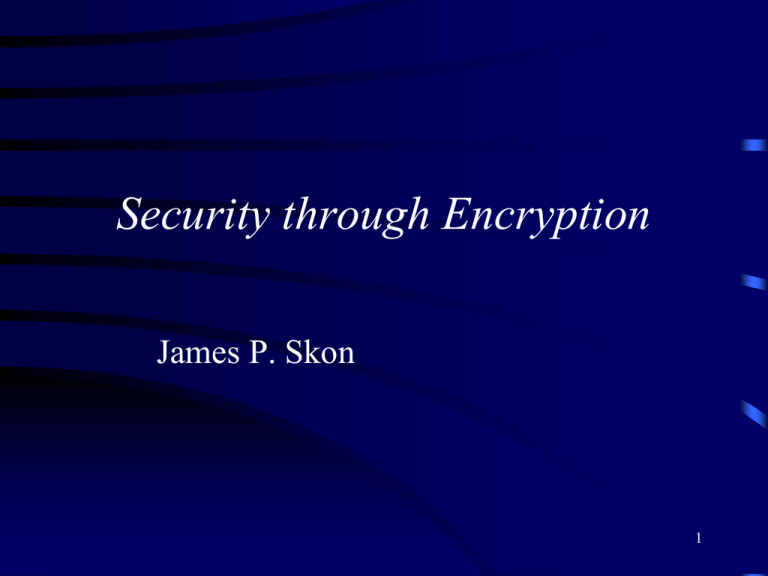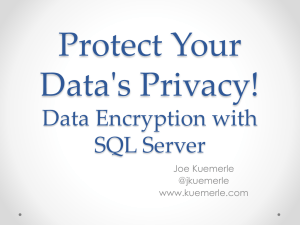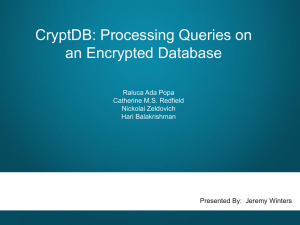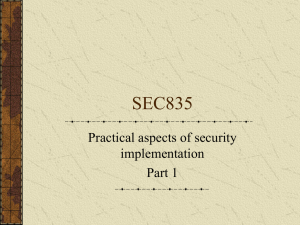Encryption
advertisement

Security through Encryption James P. Skon 1 Encryption 2 Overview • • • • • History What is encryption/decryption? Symmetrical encryption Public-key encryption Current encryption standards Encryption 3 Caesar cipher Encryption 4 German Enigma Encryption 5 Cryptography • Is – A tremendous tool – The basis for many security mechanisms • Is not – – – – The solution to all security problems Reliable unless implemented properly Reliable unless used properly Something you should try to invent yourself unless • you spend a lot of time becoming an expert • you subject your design to outside review Encryption 6 Basic Cryptographic Concepts • Encryption scheme: – functions to encrypt, decrypt data • Symmetric encryption – Block, stream ciphers, same key for both sides • Hash function, MAC – Map any input to short hash; ideally, no collisions – MAC (keyed hash) used for message integrity • Public-key cryptography – PK encryption: public key does not reveal key-1 – Signatures: sign data, Encryption verify signature 7 Unsecure message Dear Sally, The secret ... ah-ha!! Encryption 8 network transactions • Assume attackers can control the network • We will talk about how they do this later • Attackers can intercept packets, tamper with or suppress them, and inject arbitrary packets Encryption 9 Encryption Ad44fgt6&55tgt Dear Sally, Encryption Algorithm Ee8e0w8e* WEdlGlr98& d(D9ED- …. The secret ... Encryption 10 Decryption Ad44fgt6&55tgt Ee8e0w8e* WEdlGlr98& d(D9ED- …. Decryption Algorithm Encryption Dear Sally, The secret ... 11 Secure Message Ee8e0w8e*WEdl Glr98&d(D9ED fssdfsdf sfd sd- Dear Sally, Dear Sally, The secret ... The secret ... ????? Encryption 12 Encryption Source Destination insecure key Plaintext Algorithm Encrypted message Algorithm Plaintext key Encryption 13 Cryptanalysis • breaking the code with brute force computation attack • Types – – – – – Ciphertext-only attack Known-plaintext attack Chosen-plaintext attack Adaptive-chosen-plaintext attack Others... Encryption 14 Symmetric Key Encryption • Both parties must have the same key • Often encryption and decryption done by the exact same algorithm • Typically the algorithm is publicly known (only the key is secret) • Called the “secret key” method, since secrecy of key is essential Encryption 15 One-time pad Method • Each character from the plaintext is encrypted by a modular addition with a character from a secret random key (or pad) of the same length as the plaintex • Key must be length of message • Must be random, never reused Encryption 16 One Time Pad • Method – Message: "THE BRITISH ARE COMING” – Key: DKJFOISJOGIJPAPDIGN ABCDEFGHIJK L M N O P Q R S T U V W X Y Z 0 1 2 3 4 5 6 7 8 9 10 11 12 13 14 15 16 17 18 19 20 21 22 23 24 25 – Encryption (T(19)+D(03)=22) MOD 26 = 22 = W (H(07)+K(10)=17) MOD 26 = 17 = R (E(04)+J(09)=13) MOD 26 = 13 = N (B(01)+F(05)=06) MOD 26 = 06 = G Encryption (R(17)+O(14)=31) MOD 26 = 05 = F 17 One Time Pad THEBRITISHARECOMING DKJFOISJOGIJPAPDIGN Result: WRNGFQLRGNIATCDPQTT – Decryption (W(22)-D(03)= 19 +26) MOD 26 = 19 = T (R(17)-K(10)= 07 +26) MOD 26 = 07 = H (N(13)-J(09)= 04 +26) MOD 26 = 04 = E (G(06)-F(05)= 01 +26) MOD 26 = 01 = B (F(05)-O(14)=-09 +26) MOD 26 = 17 = R Encryption 18 Stream ciphers • Generate a long key with a pseudo random number generator. Encryption 19 Block Cipher • DES, AES • Build a key for each block from the start key, and the previous block Encryption 20 Strong Symmetric Key Encryption • Weak encryption is vulnerable to cryptanalysis • Strong encryption is an algorithm for which cryptanalysis is intractable (possible, but takes too long) • Strength of an algorithm is related to key length (algorithm complexity) Encryption 21 Symmetric Key Encryption Algorithms • DES (Data Encryption Standard) – 56-bit key – Adopted in 1977 by the National Bureau of Standards. – Originally proposed key length of 128-bits. – Powerful computers can now break DES. – Double and Triple DES - use two or three keys for greater safety Encryption 22 Major Systems • Data Encryption Standard (DES) 1978 – 56-bit keys – very hard to break a key • requires 255 steps on average – never been broken in genera, but can be broken for a specific key given enough CPU power. – Usually implemented in hardware Encryption 23 Major Systems • Advanced Encryption Standard – adopted by the U.S. government and is now used worldwide – Algorithm well known, generally trusted – Attacks: Brute Force Cryptoanalysis – In 2011 a key-recovery attack created which is about 4 times faster then brute force. Encryption 24 Symmetric Key Problems • How do we safely exchange keys? • How do we authenticate the source (I.e. who really sent this message) Encryption 25 Encryption • secret-key – Sender and receiver must have an identical key – Key is used for both encryption and decryption – Problems: • Secret keys must be exchanged in private. • Each side must trust each other with their secret key. • Called the key management problem. Encryption 26 Encryption • public-key – Solution to key management problem. – Each persons has a pair of keys, a public key and a private key – Public key is published in trusted directory – Private key known only to owner. Encryption 27 Encryption • public-key – Anyone can use public key to encrypt data to be sent to the owner of the public key. – ONLY the owner of the private key can decrypt the message. – Thus security is assured across unsecure media. Encryption 28 Public-key Encryption Source Destination insecure Private key Plaintext Algorithm Encrypted message Algorithm Plaintext Public key Encryption 29 Authentication • process whereby the receiver of a digital message can be confident of the identity of – the sender or – the integrity of the message Encryption 30 Authentication • Public-key Encryption provides concept of digital signature • General operation: Bob sends to Mary Mary’s Public key Message Bob’s Private key Mary’s Private key encryption algorithm function encrypted message decryption algorithm Bob’s Public key Digital signature Encryption function Message A mathematical relationship that will hold ONLY if Bob’s private key was used. 31 Advantages of Public Key Systems • Private keys need not be transmitted • Digital signature possible • Messages can be proven authentic to a third party (such as judge) allowing for legal agreements via network Encryption 32 Disadvantages of Public Key Systems • Speed – symmetrical (secret) key algorithms much, much faster – Public key very computationally intensive Encryption 33 Disadvantages of Public Key Systems • Solution to speed problem: – For a transfer, generate a random session key – Send the session key using a public key method – Use the session key with a symmetrical key algorithm for actual data transfer. Encryption 34 Crypto Policy Perspectives • Issues – Law Enforcement – National Security – Right to Privacy Encryption 35






